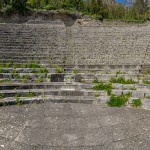Cassino is subject primarily to religious tourism and memory. The most popular destinations for tourists arriving in the City Martyr appear to be the Abbey, a destination for tourists from around the world, the Historiale and war cemeteries, places a strong attractive power for their symbolic value–sacral.
In particular, only the Abbey of Monte Cassino, founded by St. Benedict of Nursia in the year 529, considered the most famous monastery of Christianity, reaches an average of 600,000 visitors per year, confirming its position as one of the busiest holiday Lazio outside of Rome. Follows the interest also for the museum and the archaeological sites in the area including the amphitheater and the Roman theater.
Also notable is the tourist interest for Historiale, a multimedia museum dedicated to the historical events that led Cassino to become a crucial center of World War II in Italy, which is related to the interest to visit the imposing cemeteries dedicated to the victims of international ‘Second World War, the cemetery of the Commonwealth, the German Cemetery and the Polish Cemetery, where pilgrims from all over the world.
There are also those who, taking advantage of the geographical location of the city, halfway between Rome and Naples and a short distance from the Tyrrhenian Sea and the National Park of Abruzzo, Lazio and Molise, choose Cassino as a base for their excursions. Destinations nearby are Abbey Casamari Abbey Trisulti, caves Pastena, Reggia di Caserta, Formia, Gaeta, Pontine Islands, Capri, Rome and Naples.
- ABBAZIA DI MONTECASSINO
- MUSEO ARCHEOLOGICO NAZIONALE
- HISTORIALE DI CASSINO
- ROCCA JANULA
- TEATRO ROMANO
- TERME VARRONIANE
MONTECASSINO ABBEY
The abbey was founded by San Benedict in year 529, who decided to transform an antique pagan sanctuary in a monastery devoted to San Martin. In this holy site, which was home to sanctity, culture and art, San Benedict wrote the Regula Monachorum and died the 21st March 547. The remains of Saint Benedict and Saint Scolastica rest under the High Altar of the Basilica. The Abbey was destroyed by Lombards in 577, by Saracens in 883 and by an earthquake in 1349. Nothing if compared to destruction due to the massive bombing of the town on 15th February 1944, that reduced the Abbey to a pile of rubble. What we can admire today is to be due to Abbot Rea who rebuilt the Abbey following the ‘Same Place, Same State’ Programme and to the Italian Government that made the reconstruction of Montecassino a symbol of the after-war renaissance.
ARCHAEOLOGYCAL NATIONAL MUSEUM
The Cassino Archaeological Museum is situated inside the Roman town and it was built in the ’70 by the Lazio Regional Board of the Ministry of Cultural Heritage and Environmental Conservation. The exposition surface is about 300 sq.m divided in 3 halls that host finds from the early Iron Age to the Roman one. The findings are all from Cassino and the nearby area. Under the Museum floor, the Lapidarium has been recently built, where it is possible to admire ancient walls and epigraphs found in the archaeological area.
ROCCA JANULA
The Rocca Janula was built by will of Abbot Aligerno during the second half of the X century (before the town of Saint Germano was built) to create a defence against the frequent invasions. The Rocca was reinforced first by Abbot Mansone and then by Abbot Gerardo who ordered to build a chapel and the central tower, more than 20 metres high. The Rocca Janula suffered great damages from the bombing of 1944, that totally destroyed Montecassino and the town of Cassino. During last decades, the Rocca has been restored and is still under the attention of the Ministry of Cultural Heritage and Environmental Conservation.
ROMAN THEATRE
The Theatre is situated inside the old town of Casinum, its shape is semicircular and it is wide 53, 50 metres and it is believed to be from the Augustan age after the findings of a statue of the Emperor Augustus and of epitaphs on his two nephews. The cavea is divided into 4 sections and separated, there are the summa cavea of 7 stairs and the ima cavea of 13 stairs. The area of the orchestra used to be separated by a stone parapet of which few pavers are left. The upper part was destined to the entrance of the spectators through a covered tunnel still visible. The theatre was discovered in 1936 and restored the first time in 1959 and still today, it is being object of continuous restoration. Nowadays, this enchanted place gives home to art shows and classic drama.
THE HISTORIALE
The Historiale: 800 sq.m of exposition surface, 10 km. of wires, 120 sq.m of ‘huge screens’, 22 monitors, 32 DVD players, 7 video-projectors, 8 systems of audio-video programming, 65 speakers, 250 metres of suspended tracks, 280 light sources, 1 optical theatre and 1 talking head. As we said: it’s not a museum, it’s not an exhibition, it’s not a movie. With the traditional concept of a museum it shares the fact of concentrating the experience in a physical place. With modern exhibitions it shares the idea of a idea of the décor and of the educational aim. From movies, it takes a certain language of the imagination and the ability of communicating through emotions. For further informations please visit the official site: museohistoriale.org
THE TERME VARRONIANE
Romans built some thermal sites in the area of Cassino called Monticelli, right behind the train station. In that area, hundreds of water sources do spring and water has a constant temperature of 13º. The Roman ruins found in the area are from Marco Terenzio Varrone’s villa. The crystal clear waters are short in minerals making them ideal for therapeutic purposes.










